Don't wanna be here? Send us removal request.
Text
JavaScript interview questions
As you know, JavaScript is a programming language commonly used in web development. It was originally developed by Netscape as a means to add dynamic and interactive elements to websites. Like server-side scripting languages, such as PHP and ASP, JavaScript code can be inserted anywhere within the HTML of a webpage.
ReactJS basically is an open-source JavaScript library which is used for building user interfaces specifically for single-page applications. It’s used for handling view layer for web and mobile apps. React also allows us to create reusable UI components. React was first created by Jordan Walke, a software engineer working for Facebook.
Moreover, react is much faster as compared to the JavaScript frameworks. It makes use of the virtual DOM which minimizes the memory consumption and the DOM manipulation expenses.
Advantages of ReactJS
1. Simplicity: ReactJS is just simpler to grasp right away. The component-based approach, well-defined lifecycle, and use of just plain JavaScript make React very simple to learn, build a professional web (and mobile applications), and support it. React uses a special syntax called JSX which allows you to mix HTML with JavaScript. This is not a requirement; Developer can still write in plain JavaScript but JSX is much easier to use.
2. Easy to learn: Anyone with basic previous knowledge in programming can easily understand React while Angular and Ember are referred to as ‘Domain-specific Language’, implying that it is difficult to learn them. For React, you just need basic knowledge of CSS and HTML.
3. Naive Approach: React can be used to create mobile applications (React Native). And React is a diehard fan of reusability, meaning extensive code reusability is supported. So at the same time, we can make IOS, Android and Web application.
4. Data Binding: React uses one-way data binding and an application architecture called Flux controls the flow of data to components through one control point – the dispatcher. It's easier to debug self-contained components of large ReactJS apps.
5. Performance: React does not offer any concept of a built-in container for dependency. You can use Browserify, Require JS, ECMAScript 6 modules which we can use via Babel, ReactJS-di to inject dependencies automatically.
6. Testability: ReactJS applications are super easy to test. React views can be treated as functions of the state, so we can manipulate with the state we pass to the ReactJS view and take a look at the output and triggered actions, events, functions, etc.
Features of ReactJS
1. JSX: In React, instead of using regular JavaScript for templating, it uses JSX. JSX is simple JavaScript which allows HTML quoting and uses these HTML tag syntaxes to render subcomponents. HTML syntax is processed into JavaScript calls of React Framework. We can also write in pure old JavaScript.
2. React Native: React has native libraries which were announced by Facebook in 2015, which provides the react architecture to native applications like IOS, Android and UPD.
3. Single-Way data flow: In React, a set of immutable values are passed to the components renderer as properties in its HTML tags. Component cannot directly modify any properties but can pass a call back function with the help of which we can do modifications. This complete process is known as “properties flow down; actions flow up”.
Some of the interview questions that we covered in JavaScript are:
1. How do JavaScript closures work?
2. Set a default parameter value for a JavaScript function?
3. What does “use strict” do in JavaScript, and what is the reasoning behind it?
4. Is it possible to compose generator functions like you would normal functions?
5. How can I obfuscate (protect) JavaScript?
6. How can I remove a style added with .css() function?
7. How to determine if variable is 'undefined' or 'null'?
8. How to execute a JavaScript function when I have its name as a string?
9. How to execute a JavaScript function when I have its name as a string?
10. How to check for “undefined” in JavaScript?
For more details on JavaScript interview questions visit our website.
SkillPractical has JavaScript learning path that helps the user to learn the Java from scratch. If user have any questions on JavaScript while attempting tests, he can post a question in SkillPractical community. They will get an answer from our expert consultants.
0 notes
Text
JavaScript competitive tests
As you know, JavaScript is a programming language commonly used in web development. It was originally developed by Netscape as a means to add dynamic and interactive elements to websites. Like server-side scripting languages, such as PHP and ASP, JavaScript code can be inserted anywhere within the HTML of a webpage.
ReactJS basically is an open-source JavaScript library which is used for building user interfaces specifically for single-page applications. It’s used for handling view layer for web and mobile apps. React also allows us to create reusable UI components. React was first created by Jordan Walke, a software engineer working for Facebook.
Moreover, react is much faster as compared to the JavaScript frameworks. It makes use of the virtual DOM which minimizes the memory consumption and the DOM manipulation expenses.
Advantages of ReactJS
1. Simplicity: ReactJS is just simpler to grasp right away. The component-based approach, well-defined lifecycle, and use of just plain JavaScript make React very simple to learn, build a professional web (and mobile applications), and support it. React uses a special syntax called JSX which allows you to mix HTML with JavaScript. This is not a requirement; Developer can still write in plain JavaScript but JSX is much easier to use.
2. Easy to learn: Anyone with basic previous knowledge in programming can easily understand React while Angular and Ember are referred to as ‘Domain-specific Language’, implying that it is difficult to learn them. For React, you just need basic knowledge of CSS and HTML.
3. Naive Approach: React can be used to create mobile applications (React Native). And React is a diehard fan of reusability, meaning extensive code reusability is supported. So at the same time, we can make IOS, Android and Web application.
4. Data Binding: React uses one-way data binding and an application architecture called Flux controls the flow of data to components through one control point – the dispatcher. It's easier to debug self-contained components of large ReactJS apps.
5. Performance: React does not offer any concept of a built-in container for dependency. You can use Browserify, Require JS, ECMAScript 6 modules which we can use via Babel, ReactJS-di to inject dependencies automatically.
6. Testability: ReactJS applications are super easy to test. React views can be treated as functions of the state, so we can manipulate with the state we pass to the ReactJS view and take a look at the output and triggered actions, events, functions, etc.
Features of ReactJS
1. JSX: In React, instead of using regular JavaScript for templating, it uses JSX. JSX is simple JavaScript which allows HTML quoting and uses these HTML tag syntaxes to render subcomponents. HTML syntax is processed into JavaScript calls of React Framework. We can also write in pure old JavaScript.
2. React Native: React has native libraries which were announced by Facebook in 2015, which provides the react architecture to native applications like IOS, Android and UPD.
3. Single-Way data flow: In React, a set of immutable values are passed to the components renderer as properties in its HTML tags. Component cannot directly modify any properties but can pass a call back function with the help of which we can do modifications. This complete process is known as “properties flow down; actions flow up”.
The JavaScript tests that we covered in SkillPractical are: 1. JavaScript(Latest) 2. Angular 3. ReactJS 4. NodeJS
For more details on JavaScript competitive tests visit our website.
SkillPractical has JavaScript learning path that helps the user to learn the Java from scratch. If user have any questions on JavaScript while attempting tests, he can post a question in SkillPractical community. They will get an answer from our expert consultants.
0 notes
Text
JavaScript DIY Projects
As you know, JavaScript is a programming language commonly used in web development. It was originally developed by Netscape as a means to add dynamic and interactive elements to websites. Like server-side scripting languages, such as PHP and ASP, JavaScript code can be inserted anywhere within the HTML of a webpage.
ReactJS basically is an open-source JavaScript library which is used for building user interfaces specifically for single-page applications. It’s used for handling view layer for web and mobile apps. React also allows us to create reusable UI components. React was first created by Jordan Walke, a software engineer working for Facebook.
Moreover, react is much faster as compared to the JavaScript frameworks. It makes use of the virtual DOM which minimizes the memory consumption and the DOM manipulation expenses.
Advantages of ReactJS
1. Simplicity: ReactJS is just simpler to grasp right away. The component-based approach, well-defined lifecycle, and use of just plain JavaScript make React very simple to learn, build a professional web (and mobile applications), and support it. React uses a special syntax called JSX which allows you to mix HTML with JavaScript. This is not a requirement; Developer can still write in plain JavaScript but JSX is much easier to use.
2. Easy to learn: Anyone with basic previous knowledge in programming can easily understand React while Angular and Ember are referred to as ‘Domain-specific Language’, implying that it is difficult to learn them. For React, you just need basic knowledge of CSS and HTML.
3. Naive Approach: React can be used to create mobile applications (React Native). And React is a diehard fan of reusability, meaning extensive code reusability is supported. So at the same time, we can make IOS, Android and Web application.
4. Data Binding: React uses one-way data binding and an application architecture called Flux controls the flow of data to components through one control point – the dispatcher. It's easier to debug self-contained components of large ReactJS apps.
5. Performance: React does not offer any concept of a built-in container for dependency. You can use Browserify, Require JS, ECMAScript 6 modules which we can use via Babel, ReactJS-di to inject dependencies automatically.
6. Testability: ReactJS applications are super easy to test. React views can be treated as functions of the state, so we can manipulate with the state we pass to the ReactJS view and take a look at the output and triggered actions, events, functions, etc.
Features of ReactJS
1. JSX: In React, instead of using regular JavaScript for templating, it uses JSX. JSX is simple JavaScript which allows HTML quoting and uses these HTML tag syntaxes to render subcomponents. HTML syntax is processed into JavaScript calls of React Framework. We can also write in pure old JavaScript.
2. React Native: React has native libraries which were announced by Facebook in 2015, which provides the react architecture to native applications like IOS, Android and UPD.
3. Single-Way data flow: In React, a set of immutable values are passed to the components renderer as properties in its HTML tags. Component cannot directly modify any properties but can pass a call back function with the help of which we can do modifications. This complete process is known as “properties flow down; actions flow up”.
The Projects that we covered in JavaScript Learning Path are:
1. Making an EMI Calculator using HTML and JavaScript 2. Getting Started with React 3. Developing Restful webservices with Node.js & Express & Mongo DB 4. Create your first Nodejs Express App using Jade Template 5. Building JavaScript Microservices with Node.js
For more details on JavaScript DIY Projects visit our website.
SkillPractical has JavaScript learning path that helps the user to learn the Java from scratch. If user have any questions on JavaScript while attempting tests, he can post a question in SkillPractical community. They will get an answer from our expert consultants.
0 notes
Text
JavaScript Learning path for beginners
As you know, JavaScript is a programming language commonly used in web development. It was originally developed by Netscape as a means to add dynamic and interactive elements to websites. Like server-side scripting languages, such as PHP and ASP, JavaScript code can be inserted anywhere within the HTML of a webpage.
ReactJS basically is an open-source JavaScript library which is used for building user interfaces specifically for single-page applications. It’s used for handling view layer for web and mobile apps. React also allows us to create reusable UI components. React was first created by Jordan Walke, a software engineer working for Facebook.
Moreover, react is much faster as compared to the JavaScript frameworks. It makes use of the virtual DOM which minimizes the memory consumption and the DOM manipulation expenses.
Advantages of ReactJS
1. Simplicity: ReactJS is just simpler to grasp right away. The component-based approach, well-defined lifecycle, and use of just plain JavaScript make React very simple to learn, build a professional web (and mobile applications), and support it. React uses a special syntax called JSX which allows you to mix HTML with JavaScript. This is not a requirement; Developer can still write in plain JavaScript but JSX is much easier to use.
2. Easy to learn: Anyone with basic previous knowledge in programming can easily understand React while Angular and Ember are referred to as ‘Domain-specific Language’, implying that it is difficult to learn them. For React, you just need basic knowledge of CSS and HTML.
3. Naive Approach: React can be used to create mobile applications (React Native). And React is a diehard fan of reusability, meaning extensive code reusability is supported. So at the same time, we can make IOS, Android and Web application.
4. Data Binding: React uses one-way data binding and an application architecture called Flux controls the flow of data to components through one control point – the dispatcher. It's easier to debug self-contained components of large ReactJS apps.
5. Performance: React does not offer any concept of a built-in container for dependency. You can use Browserify, Require JS, ECMAScript 6 modules which we can use via Babel, ReactJS-di to inject dependencies automatically.
6. Testability: ReactJS applications are super easy to test. React views can be treated as functions of the state, so we can manipulate with the state we pass to the ReactJS view and take a look at the output and triggered actions, events, functions, etc.
Features of ReactJS
1. JSX: In React, instead of using regular JavaScript for templating, it uses JSX. JSX is simple JavaScript which allows HTML quoting and uses these HTML tag syntaxes to render subcomponents. HTML syntax is processed into JavaScript calls of React Framework. We can also write in pure old JavaScript.
2. React Native: React has native libraries which were announced by Facebook in 2015, which provides the react architecture to native applications like IOS, Android and UPD.
3. Single-Way data flow: In React, a set of immutable values are passed to the components renderer as properties in its HTML tags. Component cannot directly modify any properties but can pass a call back function with the help of which we can do modifications. This complete process is known as “properties flow down; actions flow up”.
The Projects that we covered in JavaScript Learning Path are:
1. Making an EMI Calculator using HTML and JavaScript 2. Getting Started with React 3. Developing Restful webservices with Node.js & Express & Mongo DB 4. Create your first Nodejs Express App using Jade Template 5. Building JavaScript Microservices with Node.js
For more details on JavaScript Learning path for beginners visit our website.
SkillPractical has JavaScript learning path that helps the user to learn the Java from scratch. If user have any questions on JavaScript while attempting tests, he can post a question in SkillPractical community. They will get an answer from our expert consultants.
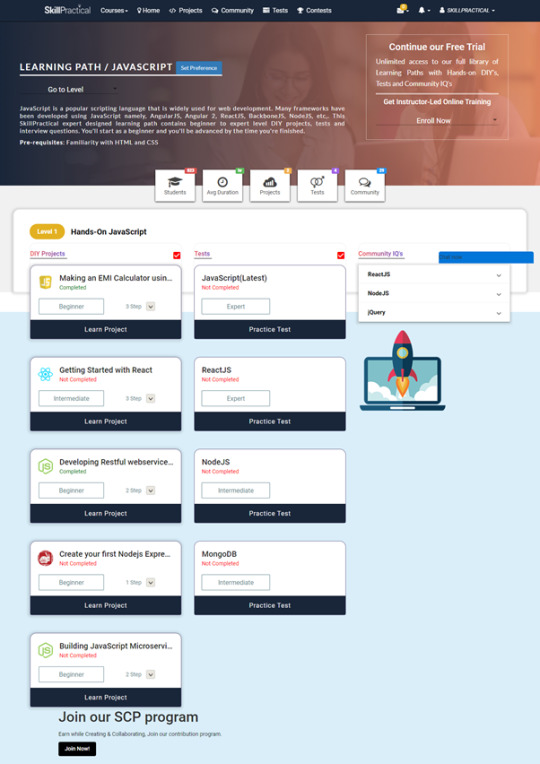
0 notes
Text
JavaScript Learning path
As you know, JavaScript is a programming language commonly used in web development. It was originally developed by Netscape as a means to add dynamic and interactive elements to websites. Like server-side scripting languages, such as PHP and ASP, JavaScript code can be inserted anywhere within the HTML of a webpage.
ReactJS basically is an open-source JavaScript library which is used for building user interfaces specifically for single-page applications. It’s used for handling view layer for web and mobile apps. React also allows us to create reusable UI components. React was first created by Jordan Walke, a software engineer working for Facebook.
React allows developers to create large web applications which can change data, without reloading the page. The main purpose of React is to be fast, scalable, and simple. It works only on user interfaces in the application. This corresponds to the view in the MVC template. It can be used with a combination of other JavaScript libraries or frameworks, such as Angular JS in MVC.
Moreover, react is much faster as compared to the JavaScript frameworks. It makes use of the virtual DOM which minimizes the memory consumption and the DOM manipulation expenses.
Advantages of ReactJS
1. Simplicity: ReactJS is just simpler to grasp right away. The component-based approach, well-defined lifecycle, and use of just plain JavaScript make React very simple to learn, build a professional web (and mobile applications), and support it. React uses a special syntax called JSX which allows you to mix HTML with JavaScript. This is not a requirement; Developer can still write in plain JavaScript but JSX is much easier to use.
2. Easy to learn: Anyone with basic previous knowledge in programming can easily understand React while Angular and Ember are referred to as ‘Domain-specific Language’, implying that it is difficult to learn them. For React, you just need basic knowledge of CSS and HTML.
3. Naive Approach: React can be used to create mobile applications (React Native). And React is a diehard fan of reusability, meaning extensive code reusability is supported. So at the same time, we can make IOS, Android and Web application.
4. Data Binding: React uses one-way data binding and an application architecture called Flux controls the flow of data to components through one control point – the dispatcher. It's easier to debug self-contained components of large ReactJS apps.
5. Performance: React does not offer any concept of a built-in container for dependency. You can use Browserify, Require JS, ECMAScript 6 modules which we can use via Babel, ReactJS-di to inject dependencies automatically.
6. Testability: ReactJS applications are super easy to test. React views can be treated as functions of the state, so we can manipulate with the state we pass to the ReactJS view and take a look at the output and triggered actions, events, functions, etc.
Features of ReactJS
1. JSX: In React, instead of using regular JavaScript for templating, it uses JSX. JSX is simple JavaScript which allows HTML quoting and uses these HTML tag syntaxes to render subcomponents. HTML syntax is processed into JavaScript calls of React Framework. We can also write in pure old JavaScript.
2. React Native: React has native libraries which were announced by Facebook in 2015, which provides the react architecture to native applications like IOS, Android and UPD.
3. Single-Way data flow: In React, a set of immutable values are passed to the components renderer as properties in its HTML tags. Component cannot directly modify any properties but can pass a call back function with the help of which we can do modifications. This complete process is known as “properties flow down; actions flow up”.
4. Virtual Document Object Model: React creates an in-memory data structure cache which computes the changes made and then updates the browser. This allows a special feature which enables the programmer to code as if the whole page is rendered on each change whereas React library only render components which actually change.
For more details on JavaScript Learning path visit our website.
SkillPractical has JavaScript learning path that helps the user to learn the Java from scratch. If user have any questions on JavaScript while attempting tests, he can post a question in SkillPractical community. They will get an answer from our expert consultants.
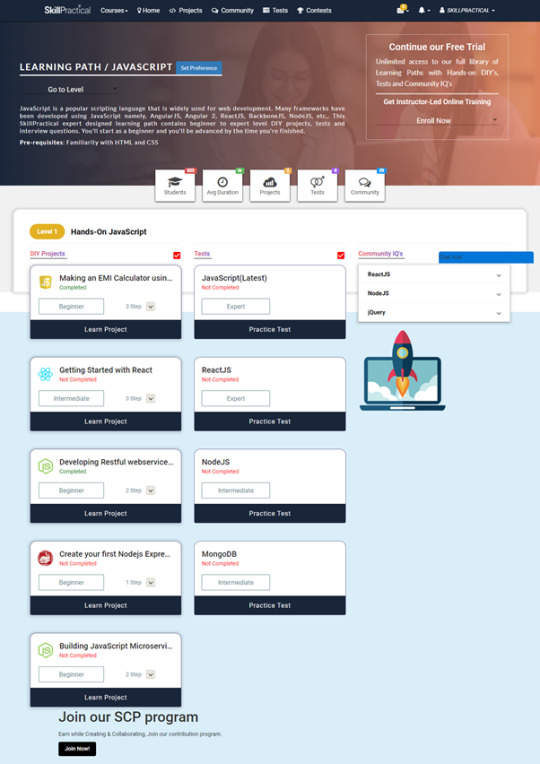
0 notes
Text
Microservices Interview Questions
Microservices is an engineering approach, which is based on building an app as a collection of small services. The main advantage is the maintainability of code. It is a surrogate method to a serverless approach. Microservices certainly bring more business value but at the same time, it requires a stable and secure technology such as Node.js to develop apps without complexities. Microservices developed in Node.js is most appropriate for enterprise-level projects for improving maintainability.
Microservices are a single self-functional system which, along with other units, form a complex system. Each small unit of the system is a fully functional, scalable, and deployable system. Each unit can be written in different programming languages and tested separately without causing an impact on other parts of the system. Microservices are the big block made up of smaller sub-blocks (Services), with each sub-block being an independent operating unit. If any of the unit (services) goes wrong, it will not take long to replace that service, which in turn reduces the risk of development and the costs involved in the operation of the infrastructure. This architecture is widely used by world-famous organizations including Uber, Netflix, Amazon, eBay, Groupon, and many more. Microservices are not coupled with any technology say Java or Node. You are free to choose any technology to build systems with Microservices style.
Monolithic
Understanding a huge code base becomes difficult, especially for new developers.
Large code files make the development environment slow, like IDE.
Changing technology or language becomes complicated as the code base is tightly coupled.
CI/CD becomes challenging and time-consuming and needs a dedicated team to manage it.
Microservices
They are small and specific to business requirement.
Loosely coupled and can be easily developed and deployed.
Development can be done using different technologies.
Microservices can be built with new technology stack enabling faster development cycles.
Can be easily scaled on demand.
Compared to monolithic architecture, microservices are hands down more beneficial. You don’t need to stuff all software components and services in one big container and pack them tightly.
Building JavaScript applications on microservices help you focus on developing monofunctional modules with clearly defined operations and precise interfaces. The application development process becomes more agile, and the challenges of continuous testing are mitigated. When you build applications on a monolithic architecture, the entire application needs to be deployed with every update.
On the other hand, microservices have no dependency on the type of framework, technique, or programming language being used to build them. Your ability to release REST-ful APIs for communication and other services is the only requisite for microservice architecture.
Note: Different enterprises like Go Daddy, Paypal, Netflix have used this strategy to create scalable applications.
The projects steps that we covered in this project are:
1. Why externalize configuration properties 2. Dynamic routing using Netflix Zuul 3. Client-side load balancing using Netflix Ribbon
Some of the interview questions that we covered in the SkillPractical Spring are:
1. What is Confused Deputy Problem in security context?
2. What is a Gateway in microservice?
3. When designing Microservices, what are the best practices to follow?
4. What are the challenges you face while working Microservice Architectures?
5. Shed light on the basic need of Microservices in today’s context of application development?
6. Which DB is preferred by Microservices based Architecture?
7. Why Would You Need Reports & Dashboards In Microservices?
8. How Would You Perform Security Testing of Microservices?
9. What Are Some Major Roadblocks For Microservices Testing?
10. How can we separate Deployment from Release of Microservices?
For more details on Microservices Interview Questions please visit our website.
SkillPractical has Microservices learning path that helps the user to learn the Java from scratch. If user have any questions on Java Microservices while attempting tests, he can post a question in SkillPractical community. They will get an answer from our expert consultants.
0 notes
Text
Microservices competitive tests
Microservices is an engineering approach, which is based on building an app as a collection of small services. The main advantage is the maintainability of code. It is a surrogate method to a serverless approach. Microservices certainly bring more business value but at the same time, it requires a stable and secure technology such as Node.js to develop apps without complexities. Microservices developed in Node.js is most appropriate for enterprise-level projects for improving maintainability.
Microservices are a single self-functional system which, along with other units, form a complex system. Each small unit of the system is a fully functional, scalable, and deployable system. Each unit can be written in different programming languages and tested separately without causing an impact on other parts of the system. Microservices are the big block made up of smaller sub-blocks (Services), with each sub-block being an independent operating unit. If any of the unit (services) goes wrong, it will not take long to replace that service, which in turn reduces the risk of development and the costs involved in the operation of the infrastructure. This architecture is widely used by world-famous organizations including Uber, Netflix, Amazon, eBay, Groupon, and many more. Microservices are not coupled with any technology say Java or Node. You are free to choose any technology to build systems with Microservices style.
Monolithic
Understanding a huge code base becomes difficult, especially for new developers.
Large code files make the development environment slow, like IDE.
Changing technology or language becomes complicated as the code base is tightly coupled.
CI/CD becomes challenging and time-consuming and needs a dedicated team to manage it.
Microservices
They are small and specific to business requirement.
Loosely coupled and can be easily developed and deployed.
Development can be done using different technologies.
Microservices can be built with new technology stack enabling faster development cycles.
Can be easily scaled on demand.
Compared to monolithic architecture, microservices are hands down more beneficial. You don’t need to stuff all software components and services in one big container and pack them tightly.
Building JavaScript applications on microservices help you focus on developing monofunctional modules with clearly defined operations and precise interfaces. The application development process becomes more agile, and the challenges of continuous testing are mitigated. When you build applications on a monolithic architecture, the entire application needs to be deployed with every update.
On the other hand, microservices have no dependency on the type of framework, technique, or programming language being used to build them. Your ability to release REST-ful APIs for communication and other services is the only requisite for microservice architecture.
Note: Different enterprises like Go Daddy, Paypal, Netflix have used this strategy to create scalable applications.
The projects steps that we covered in this project are:
1. Why externalize configuration properties 2. Dynamic routing using Netflix Zuul 3. Client-side load balancing using Netflix Ribbon
The competitive tests we cover in SkillPractical are:
1. Spring Rest Test 2. Node JS and etc..
For more details on Microservices competitive tests please visit our website.
SkillPractical has Microservices learning path that helps the user to learn the Java from scratch. If user have any questions on Java Microservices while attempting tests, he can post a question in SkillPractical community. They will get an answer from our expert consultants.
0 notes
Text
Microservices DIY Projects
Microservices is an engineering approach, which is based on building an app as a collection of small services. The main advantage is the maintainability of code. It is a surrogate method to a serverless approach. Microservices certainly bring more business value but at the same time, it requires a stable and secure technology such as Node.js to develop apps without complexities. Microservices developed in Node.js is most appropriate for enterprise-level projects for improving maintainability.
Microservices are a single self-functional system which, along with other units, form a complex system. Each small unit of the system is a fully functional, scalable, and deployable system. Each unit can be written in different programming languages and tested separately without causing an impact on other parts of the system. Microservices are the big block made up of smaller sub-blocks (Services), with each sub-block being an independent operating unit. If any of the unit (services) goes wrong, it will not take long to replace that service, which in turn reduces the risk of development and the costs involved in the operation of the infrastructure. This architecture is widely used by world-famous organizations including Uber, Netflix, Amazon, eBay, Groupon, and many more. Microservices are not coupled with any technology say Java or Node. You are free to choose any technology to build systems with Microservices style.
Monolithic
Understanding a huge code base becomes difficult, especially for new developers.
Large code files make the development environment slow, like IDE.
Changing technology or language becomes complicated as the code base is tightly coupled.
CI/CD becomes challenging and time-consuming and needs a dedicated team to manage it.
Microservices
They are small and specific to business requirement.
Loosely coupled and can be easily developed and deployed.
Development can be done using different technologies.
Microservices can be built with new technology stack enabling faster development cycles.
Can be easily scaled on demand.
Compared to monolithic architecture, microservices are hands down more beneficial. You don’t need to stuff all software components and services in one big container and pack them tightly.
Building JavaScript applications on microservices help you focus on developing monofunctional modules with clearly defined operations and precise interfaces. The application development process becomes more agile, and the challenges of continuous testing are mitigated. When you build applications on a monolithic architecture, the entire application needs to be deployed with every update.
On the other hand, microservices have no dependency on the type of framework, technique, or programming language being used to build them. Your ability to release REST-ful APIs for communication and other services is the only requisite for microservice architecture.
Note: Different enterprises like Go Daddy, Paypal, Netflix have used this strategy to create scalable applications.
The projects steps that we covered in this project are:
1. Why externalize configuration properties 2. Dynamic routing using Netflix Zuul 3. Client-side load balancing using Netflix Ribbon
The projects that we covered in the SkillPractical Microservices Learning path are:
1. Building JavaScript Microservices with Node.js 2. Developing Microservices with Spring Boot & Spring Cloud - Part 1 3. Developing Microservices with Spring Boot & Spring Cloud - Part 2 and etc..
For more details on Microservices DIY Projects please visit our website.
SkillPractical has Microservices learning path that helps the user to learn the Java from scratch. If user have any questions on Java Microservices while attempting tests, he can post a question in SkillPractical community. They will get an answer from our expert consultants.
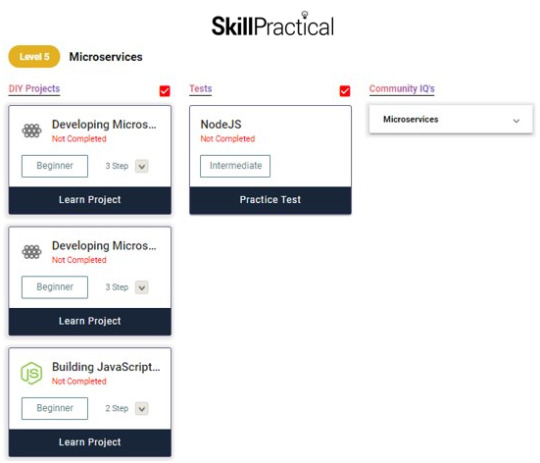
0 notes
Text
Microservices Learning Path
Microservices is an engineering approach, which is based on building an app as a collection of small services. The main advantage is the maintainability of code. It is a surrogate method to a serverless approach. Microservices certainly bring more business value but at the same time, it requires a stable and secure technology such as Node.js to develop apps without complexities. Microservices developed in Node.js is most appropriate for enterprise-level projects for improving maintainability.
Microservices are a single self-functional system which, along with other units, form a complex system. Each small unit of the system is a fully functional, scalable, and deployable system. Each unit can be written in different programming languages and tested separately without causing an impact on other parts of the system. Microservices are the big block made up of smaller sub-blocks (Services), with each sub-block being an independent operating unit. If any of the unit (services) goes wrong, it will not take long to replace that service, which in turn reduces the risk of development and the costs involved in the operation of the infrastructure. This architecture is widely used by world-famous organizations including Uber, Netflix, Amazon, eBay, Groupon, and many more. Microservices are not coupled with any technology say Java or Node. You are free to choose any technology to build systems with Microservices style.
Microservices
They are small and specific to business requirement.
Loosely coupled and can be easily developed and deployed.
Development can be done using different technologies.
Microservices can be built with new technology stack enabling faster development cycles.
Can be easily scaled on demand.
Compared to monolithic architecture, microservices are hands down more beneficial. You don’t need to stuff all software components and services in one big container and pack them tightly.
Building JavaScript applications on microservices help you focus on developing monofunctional modules with clearly defined operations and precise interfaces. The application development process becomes more agile, and the challenges of continuous testing are mitigated. When you build applications on a monolithic architecture, the entire application needs to be deployed with every update.
On the other hand, microservices have no dependency on the type of framework, technique, or programming language being used to build them. Your ability to release REST-ful APIs for communication and other services is the only requisite for microservice architecture.
Note: Different enterprises like Go Daddy, Paypal, Netflix have used this strategy to create scalable applications.
The projects that we covered in the SkillPractical Microservices Learning path are:
1. Building JavaScript Microservices with Node.js 2. Developing Microservices with Spring Boot & Spring Cloud - Part 1 3. Developing Microservices with Spring Boot & Spring Cloud - Part 2 and etc..
For more details on Microservices Learning Path please visit our website.
SkillPractical has Microservices learning path that helps the user to learn the Java from scratch. If user have any questions on Java Microservices while attempting tests, he can post a question in SkillPractical community. They will get an answer from our expert consultants.
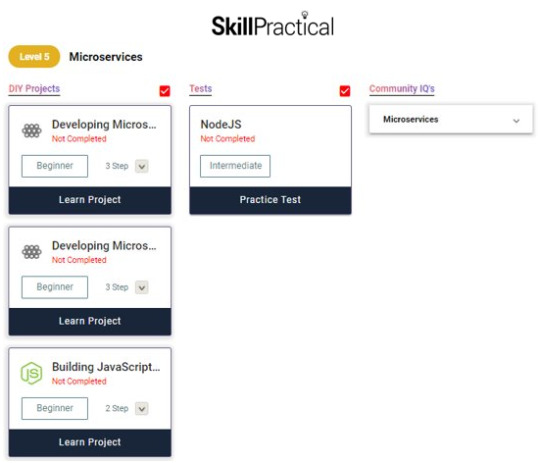
0 notes
Text
SpringBoot interview questions
Using the spring framework, you can build an enterprise java application. On other hand, spring provides a template for common services like Transaction Management, Garbage collection. So, that developer can focus on writing business logic and the framework can take care of all the common concerns or common functionality. Additionally, Spring provides infrastructure support like DB connectivity.
But Spring framework served its purpose from the last 10 years that too, we need to do a lot of setup and configuration to make the spring framework work the way you want.
Also, Build and Deployment effort could still be high with a Spring framework Application. That’s were spring boot got many eyes.
Using Spring Boot, you can bootstrap or quickly start a Spring Application with minimal configurations.
Introduction to Microservices:
In one word told by Adrian Cockcroft who is known for a modern microservices architecture, “Microservices are loosely coupled service-oriented architecture with bounded context”.
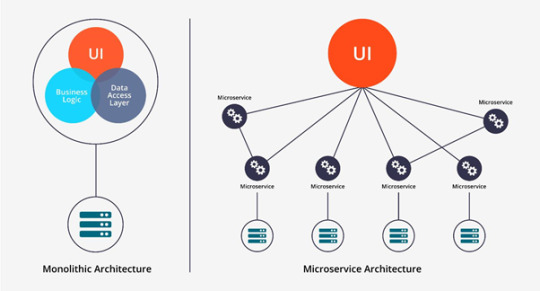
Instead of going more on theory Let’s see a real-world requirement and break it how to build it in both monolithic and microservices way.
Requirement:
When we have a development requirement.
Example: Build a Movie Catalog application with Movie and capable of having other services.
If we follow the monolithic way,
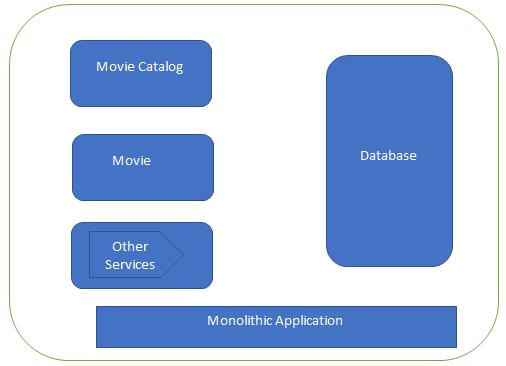
We can follow the above traditional monolithic approach like above, having different modules like Movie Catalog, Movie, etc... and then have one database to manage information for different modules. But, the challenge with this approach is a minor issue with one of the areas can take down the entire application. Also, there will be a lot of interdependencies between these modules we will be managed during the development phase. To solve all the issues with the monolithic approach we can follow the most modern approach is a microservices-based approach.
If we follow microservices way,
Fetch Movie Information from MovieApp and corresponding information from Other Service and display in the MovieCatalog Service.
All of the services and independent, they and build and deployed independently. They will have their own database.
MovieCatalog Service will be the entry point for the application which internally look up MovieApp and Other services to get the desired data and display to the End-user.
This is a very basic example but we will be covering all the concepts of microservices and you will feel confident about building a similar application in the real world.
Let’s start Building Microservices with the Requirement we have:
Software’s Required: Java, STS, Maven build tool, MySQL Database, SQL Developer community edition, Postman Client.
The steps that we covered in this project are:
1. Creating Spring Boot Project MovieApp Service 2. Service Discovery 3. Creating Spring Boot Project MovieCatalog Service and Integrating MovieApp
Some of the interview questions that we covered in the SkillPractical Spring are:
1. Mention some of the configuration parameters available in Spring Boot? 2. How do you achieve transaction management? 3. Difference between conditional annotation and profiles? 4. What is Spring Data REST? 5. What do you understand by auto-configuration. How can you write a custom auto-configuration? 6. What is actuator and how do you configure? 7. What are Spring Boot starters? 8. What does annotation @SpringBootApplication do? 9. Mention some of the Spring Boot’s test features? 10. Explain Spring boot conditional annotations and give use cases to use them?
For more details on SpringBoot interview questions please visit our website.
SkillPractical has Spring learning path that helps the user to learn the Java from scratch. If user have any questions on Java Spring while attempting tests, he can post a question in SkillPractical community. They will get an answer from our expert consultants.
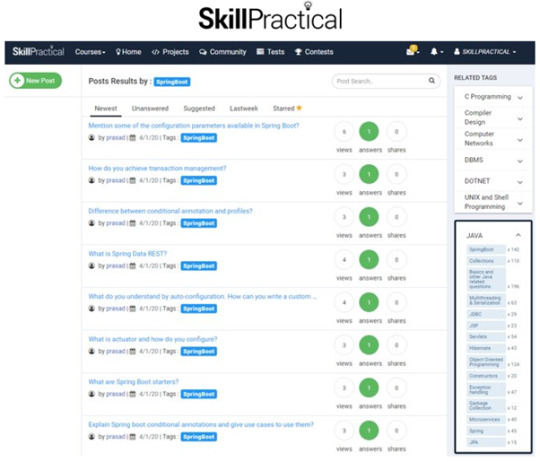
0 notes
Text
SpringBoot competitive tests
Using the spring framework, you can build an enterprise java application. On other hand, spring provides a template for common services like Transaction Management, Garbage collection. So, that developer can focus on writing business logic and the framework can take care of all the common concerns or common functionality. Additionally, Spring provides infrastructure support like DB connectivity.
But Spring framework served its purpose from the last 10 years that too, we need to do a lot of setup and configuration to make the spring framework work the way you want.
Also, Build and Deployment effort could still be high with a Spring framework Application. That’s were spring boot got many eyes.
Using Spring Boot, you can bootstrap or quickly start a Spring Application with minimal configurations.
Introduction to Microservices:
In one word told by Adrian Cockcroft who is known for a modern microservices architecture, “Microservices are loosely coupled service-oriented architecture with bounded context”.
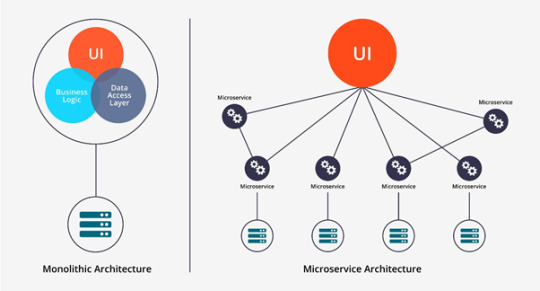
Instead of going more on theory Let’s see a real-world requirement and break it how to build it in both monolithic and microservices way.
Requirement:
When we have a development requirement.
Example: Build a Movie Catalog application with Movie and capable of having other services.
If we follow the monolithic way,
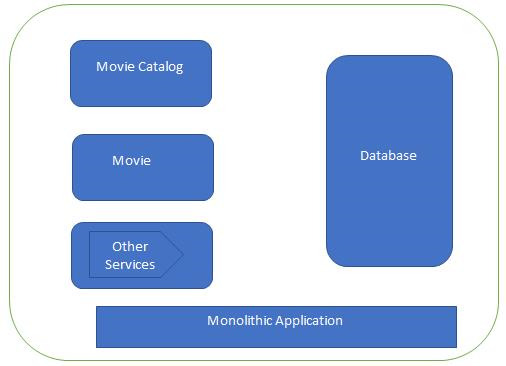
We can follow the above traditional monolithic approach like above, having different modules like Movie Catalog, Movie, etc... and then have one database to manage information for different modules. But, the challenge with this approach is a minor issue with one of the areas can take down the entire application. Also, there will be a lot of interdependencies between these modules we will be managed during the development phase. To solve all the issues with the monolithic approach we can follow the most modern approach is a microservices-based approach.
If we follow microservices way,

Fetch Movie Information from MovieApp and corresponding information from Other Service and display in the MovieCatalog Service.
All of the services and independent, they and build and deployed independently. They will have their own database.
MovieCatalog Service will be the entry point for the application which internally look up MovieApp and Other services to get the desired data and display to the End-user.
This is a very basic example but we will be covering all the concepts of microservices and you will feel confident about building a similar application in the real world.
Let’s start Building Microservices with the Requirement we have:
Software’s Required: Java, STS, Maven build tool, MySQL Database, SQL Developer community edition, Postman Client.
The steps that we covered in this project are:
1. Creating Spring Boot Project MovieApp Service 2. Service Discovery 3. Creating Spring Boot Project MovieCatalog Service and Integrating MovieApp
For more details on SpringBoot competitive tests please visit our website.
SkillPractical has SpringBoot learning path that helps the user to learn the Java from scratch. If user have any questions on Java Spring while attempting tests, he can post a question in SkillPractical community. They will get an answer from our expert consultants.
The competitive tests we cover in SkillPractical are:
1. Spring Rest Test 2. SpringBoot Test 3. Rest API Test and etc..
0 notes
Text
SpringBoot DIY projects
Using the spring framework, you can build an enterprise java application. On other hand, spring provides a template for common services like Transaction Management, Garbage collection. So, that developer can focus on writing business logic and the framework can take care of all the common concerns or common functionality. Additionally, Spring provides infrastructure support like DB connectivity.
But Spring framework served its purpose from the last 10 years that too, we need to do a lot of setup and configuration to make the spring framework work the way you want.
Also, Build and Deployment effort could still be high with a Spring framework Application. That’s were spring boot got many eyes.
Using Spring Boot, you can bootstrap or quickly start a Spring Application with minimal configurations.
Introduction to Microservices:
In one word told by Adrian Cockcroft who is known for a modern microservices architecture, “Microservices are loosely coupled service-oriented architecture with bounded context”.
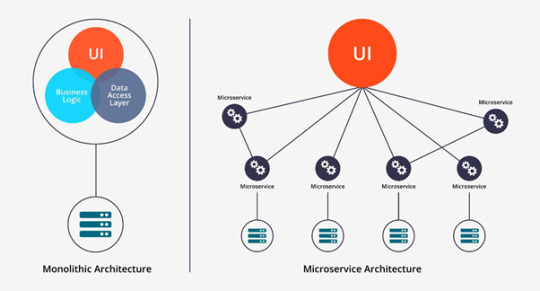
Instead of going more on theory Let’s see a real-world requirement and break it how to build it in both monolithic and microservices way.
Requirement:
When we have a development requirement.
Example: Build a Movie Catalog application with Movie and capable of having other services.
If we follow the monolithic way,

We can follow the above traditional monolithic approach like above, having different modules like Movie Catalog, Movie, etc... and then have one database to manage information for different modules. But, the challenge with this approach is a minor issue with one of the areas can take down the entire application. Also, there will be a lot of interdependencies between these modules we will be managed during the development phase. To solve all the issues with the monolithic approach we can follow the most modern approach is a microservices-based approach.
If we follow microservices way,
Fetch Movie Information from MovieApp and corresponding information from Other Service and display in the MovieCatalog Service.
All of the services and independent, they and build and deployed independently. They will have their own database.
MovieCatalog Service will be the entry point for the application which internally look up MovieApp and Other services to get the desired data and display to the End-user.
This is a very basic example but we will be covering all the concepts of microservices and you will feel confident about building a similar application in the real world.
Let’s start Building Microservices with the Requirement we have:
Software’s Required: Java, STS, Maven build tool, MySQL Database, SQL Developer community edition, Postman Client.
The steps that we covered in this project are:
1. Creating Spring Boot Project MovieApp Service 2. Service Discovery 3. Creating Spring Boot Project MovieCatalog Service and Integrating MovieApp
The projects that we covered in the SkillPractical Spring are:
1. SpringBoot Getting Started 2. Create your SpringBoot App with Servlet/JSP/JDBC 3. Creating Your First RESTful Web Service with Java/SpringBoot 4. Developing Microservices with Spring Boot & Spring Cloud - Part 1 5. Developing Microservices with Spring Boot & Spring Cloud - Part 2 and etc..
For more details on SpringBoot DIY Projects please visit our website.
SkillPractical has SpringBoot learning path that helps the user to learn the Java from scratch. If user have any questions on Java Spring while attempting tests, he can post a question in SkillPractical community. They will get an answer from our expert consultants.
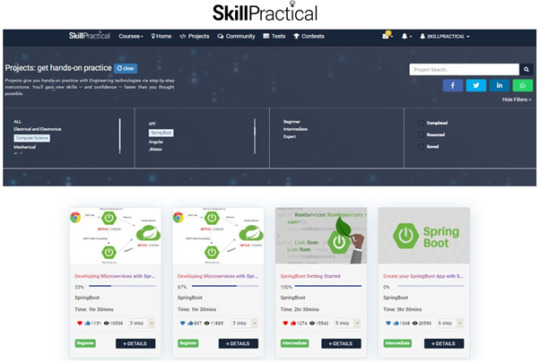
0 notes
Text
SpringBoot Learning Path
Using the spring framework, you can build an enterprise java application. On other hand, spring provides a template for common services like Transaction Management, Garbage collection. So, that developer can focus on writing business logic and the framework can take care of all the common concerns or common functionality. Additionally, Spring provides infrastructure support like DB connectivity.
But Spring framework served its purpose from the last 10 years that too, we need to do a lot of setup and configuration to make the spring framework work the way you want.
Also, Build and Deployment effort could still be high with a Spring framework Application. That’s were spring boot got many eyes.
Using Spring Boot, you can bootstrap or quickly start a Spring Application with minimal configurations.
Introduction to Microservices:
In one word told by Adrian Cockcroft who is known for a modern microservices architecture, “Microservices are loosely coupled service-oriented architecture with bounded context”.

Instead of going more on theory Let’s see a real-world requirement and break it how to build it in both monolithic and microservices way.
Requirement:
When we have a development requirement.
Example: Build a Movie Catalog application with Movie and capable of having other services.
If we follow the monolithic way,
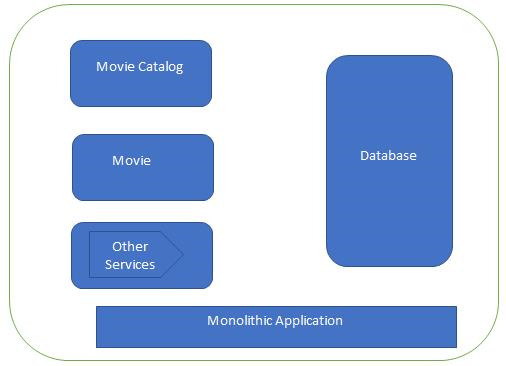
We can follow the above traditional monolithic approach like above, having different modules like Movie Catalog, Movie, etc... and then have one database to manage information for different modules. But, the challenge with this approach is a minor issue with one of the areas can take down the entire application. Also, there will be a lot of interdependencies between these modules we will be managed during the development phase. To solve all the issues with the monolithic approach we can follow the most modern approach is a microservices-based approach.
If we follow microservices way,
Fetch Movie Information from MovieApp and corresponding information from Other Service and display in the MovieCatalog Service.
All of the services and independent, they and build and deployed independently. They will have their own database.
MovieCatalog Service will be the entry point for the application which internally look up MovieApp and Other services to get the desired data and display to the End-user.
This is a very basic example but we will be covering all the concepts of microservices and you will feel confident about building a similar application in the real world.
Let’s start Building Microservices with the Requirement we have:
Software’s Required: Java, STS, Maven build tool, MySQL Database, SQL Developer community edition, Postman Client.
The steps that we covered in this project are:
1. Creating Spring Boot Project MovieApp Service 2. Service Discovery 3. Creating Spring Boot Project MovieCatalog Service and Integrating MovieApp
The projects that we covered in the SkillPractical SpringBoot Learning path are:
1. SpringBoot Getting Started 2. Create your SpringBoot App with Servlet/JSP/JDBC 3. Creating Your First RESTful Web Service with Java/SpringBoot 4. Developing Microservices with Spring Boot & Spring Cloud - Part 1 5. Developing Microservices with Spring Boot & Spring Cloud - Part 2 and etc..
For more details on SpringBoot Learning path please visit our website.
SkillPractical has SpringBoot learning path that helps the user to learn the Java from scratch. If user have any questions on Java Spring while attempting tests, he can post a question in SkillPractical community. They will get an answer from our expert consultants.

0 notes
Text
SkillPractical Spring Interview Questions
Spring Boot is an open-source Java-based framework. Spring Boot is a utility for setting up an application quickly by automating the configuration procedures and speed up the process of building and deploying Spring Boot applications. It is easy to create production-ready applications using Spring Boot through embedded server(tomcat).
Spring is widely used for creating scalable applications. For web applications Spring provides Spring MVC which is a widely used module of spring that is used to create scalable web applications. But the main disadvantage of spring projects is that configuration is really time-consuming and can be a bit overwhelming for the new developers. Making the application production-ready takes some time if you are new to the spring.
Here in this project, we will discuss how to create a basic RESTful web service which displays the list of student details and details of individual student depending upon the id provided through the REST call i.e.., depending upon the input provided through the REST call.
Prerequisites:
Basic understanding of how to create a Maven project in IntelliJ IDE.
Basic understanding of RESTful web services.
Basic understanding of HTTP Methods i.e., GET, PUT, POST, DELETE etc..
Advantages of RESTful Web services:
The separation between the client and the server: The REST protocol totally separates the user interface from the server and the data storage. This has some advantages when making developments. For example, it improves the portability of the interface to other types of platforms, it increases the scalability of the projects and allows the different components of the developments to be evolved independently.
Visibility, reliability, and scalability: The separation between client and server has one evident advantage, and that is that each development team can scale the product without too much problem. They can migrate to other servers or make all kinds of changes in the database, provided the data from each request is sent correctly. The separation makes it easier to have the front and the back on different servers, and this makes the apps more flexible to work with.
The REST API is always independent of the type of platform or languages: The REST API always adapts to the type of syntax or platforms being used, which gives considerable freedom when changing or testing new environments within the development. With a REST API, you can have PHP, Java, Python or Node.js servers. The only thing is that it is indispensable that the responses to the requests should always take place in the language used for the information exchange, normally XML or JSON.
The steps that we covered in this project are:
1. Create a maven project and ass dependencies 2. Create a minimal set of classes and launch the application 3. Add at least one controller with respective Services, Entity and DAO (Data Access Object)
Some of the interview questions that we covered in the SkillPractical Spring are:
1. Mention some of the configuration parameters available in Spring Boot? 2. How do you achieve transaction management? 3. Difference between conditional annotation and profiles? 4. What is Spring Data REST? 5. What do you understand by auto-configuration. How can you write a custom auto-configuration? 6. What is actuator and how do you configure? 7. What are Spring Boot starters? 8. What does annotation @SpringBootApplication do? 9. Mention some of the Spring Boot’s test features? 10. Explain Spring boot conditional annotations and give use cases to use them?
For more details on Spring interview questions please visit our website.
SkillPractical has Spring learning path that helps the user to learn the Java from scratch. If user have any questions on Java Spring while attempting tests, he can post a question in SkillPractical community. They will get an answer from our expert consultants.
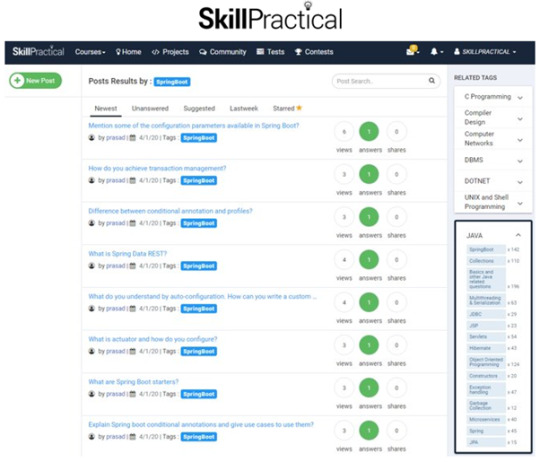
0 notes
Text
SkillPractical Spring competitive tests
Spring Boot is an open-source Java-based framework. Spring Boot is a utility for setting up an application quickly by automating the configuration procedures and speed up the process of building and deploying Spring Boot applications. It is easy to create production-ready applications using Spring Boot through embedded server(tomcat).
Spring is widely used for creating scalable applications. For web applications Spring provides Spring MVC which is a widely used module of spring that is used to create scalable web applications. But the main disadvantage of spring projects is that configuration is really time-consuming and can be a bit overwhelming for the new developers. Making the application production-ready takes some time if you are new to the spring.
Here in this project, we will discuss how to create a basic RESTful web service which displays the list of student details and details of individual student depending upon the id provided through the REST call i.e.., depending upon the input provided through the REST call.
Prerequisites:
Basic understanding of how to create a Maven project in IntelliJ IDE.
Basic understanding of RESTful web services.
Basic understanding of HTTP Methods i.e., GET, PUT, POST, DELETE etc..
Advantages of RESTful Web services:
The separation between the client and the server: The REST protocol totally separates the user interface from the server and the data storage. This has some advantages when making developments. For example, it improves the portability of the interface to other types of platforms, it increases the scalability of the projects and allows the different components of the developments to be evolved independently.
Visibility, reliability, and scalability: The separation between client and server has one evident advantage, and that is that each development team can scale the product without too much problem. They can migrate to other servers or make all kinds of changes in the database, provided the data from each request is sent correctly. The separation makes it easier to have the front and the back on different servers, and this makes the apps more flexible to work with.
The REST API is always independent of the type of platform or languages: The REST API always adapts to the type of syntax or platforms being used, which gives considerable freedom when changing or testing new environments within the development. With a REST API, you can have PHP, Java, Python or Node.js servers. The only thing is that it is indispensable that the responses to the requests should always take place in the language used for the information exchange, normally XML or JSON.
The steps that we covered in this project are:
1. Create a maven project and ass dependencies 2. Create a minimal set of classes and launch the application 3. Add at least one controller with respective Services, Entity and DAO (Data Access Object)
For more details on Spring competitive tests please visit our website.
SkillPractical has Spring learning path that helps the user to learn the Java from scratch. If user have any questions on Java Spring while attempting tests, he can post a question in SkillPractical community. They will get an answer from our expert consultants.
The competitive tests we cover in SkillPractical are:
1. Spring Rest Test 2. SpringBoot Test 3. Rest API Test and etc..
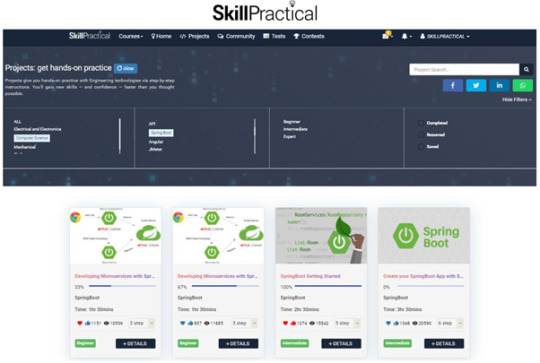
0 notes
Text
SkillPractical Spring DIY Projects
Spring Boot is an open-source Java-based framework. Spring Boot is a utility for setting up an application quickly by automating the configuration procedures and speed up the process of building and deploying Spring Boot applications. It is easy to create production-ready applications using Spring Boot through embedded server(tomcat).
Spring is widely used for creating scalable applications. For web applications Spring provides Spring MVC which is a widely used module of spring that is used to create scalable web applications. But the main disadvantage of spring projects is that configuration is really time-consuming and can be a bit overwhelming for the new developers. Making the application production-ready takes some time if you are new to the spring.
Here in this project, we will discuss how to create a basic RESTful web service which displays the list of student details and details of individual student depending upon the id provided through the REST call i.e.., depending upon the input provided through the REST call.
Prerequisites:
Basic understanding of how to create a Maven project in IntelliJ IDE.
Basic understanding of RESTful web services.
Basic understanding of HTTP Methods i.e., GET, PUT, POST, DELETE etc..
Advantages of RESTful Web services:
The separation between the client and the server: The REST protocol totally separates the user interface from the server and the data storage. This has some advantages when making developments. For example, it improves the portability of the interface to other types of platforms, it increases the scalability of the projects and allows the different components of the developments to be evolved independently.
Visibility, reliability, and scalability: The separation between client and server has one evident advantage, and that is that each development team can scale the product without too much problem. They can migrate to other servers or make all kinds of changes in the database, provided the data from each request is sent correctly. The separation makes it easier to have the front and the back on different servers, and this makes the apps more flexible to work with.
The REST API is always independent of the type of platform or languages: The REST API always adapts to the type of syntax or platforms being used, which gives considerable freedom when changing or testing new environments within the development. With a REST API, you can have PHP, Java, Python or Node.js servers. The only thing is that it is indispensable that the responses to the requests should always take place in the language used for the information exchange, normally XML or JSON.
The steps that we covered in this project are:
1. Create a maven project and ass dependencies 2. Create a minimal set of classes and launch the application 3. Add at least one controller with respective Services, Entity and DAO (Data Access Object)
The steps that we covered in this project are:
1. Create a maven project and ass dependencies 2. Create a minimal set of classes and launch the application 3. Add at least one controller with respective Services, Entity and DAO (Data Access Object)
The projects that we covered in the SkillPractical Spring are:
1. SpringBoot Getting Started 2. Create your SpringBoot App with Servlet/JSP/JDBC 3. Creating Your First RESTful Web Service with Java/SpringBoot 4. Developing Microservices with Spring Boot & Spring Cloud - Part 1 5. Developing Microservices with Spring Boot & Spring Cloud - Part 2 and etc..
For more details on Spring DIY Projects please visit our website.
SkillPractical has Spring learning path that helps the user to learn the Java from scratch. If user have any questions on Java Spring while attempting tests, he can post a question in SkillPractical community. They will get an answer from our expert consultants.

0 notes
Text
SkillPractical Spring Learning Path for Beginners
Spring Boot is an open-source Java-based framework. Spring Boot is a utility for setting up an application quickly by automating the configuration procedures and speed up the process of building and deploying Spring Boot applications. It is easy to create production-ready applications using Spring Boot through embedded server(tomcat).
Spring is widely used for creating scalable applications. For web applications Spring provides Spring MVC which is a widely used module of spring that is used to create scalable web applications. But the main disadvantage of spring projects is that configuration is really time-consuming and can be a bit overwhelming for the new developers. Making the application production-ready takes some time if you are new to the spring.
Here in this project, we will discuss how to create a basic RESTful web service which displays the list of student details and details of individual student depending upon the id provided through the REST call i.e.., depending upon the input provided through the REST call.
Prerequisites:
Basic understanding of how to create a Maven project in IntelliJ IDE.
Basic understanding of RESTful web services.
Basic understanding of HTTP Methods i.e., GET, PUT, POST, DELETE etc..
Advantages of RESTful Web services:
The separation between the client and the server: The REST protocol totally separates the user interface from the server and the data storage. This has some advantages when making developments. For example, it improves the portability of the interface to other types of platforms, it increases the scalability of the projects and allows the different components of the developments to be evolved independently.
Visibility, reliability, and scalability: The separation between client and server has one evident advantage, and that is that each development team can scale the product without too much problem. They can migrate to other servers or make all kinds of changes in the database, provided the data from each request is sent correctly. The separation makes it easier to have the front and the back on different servers, and this makes the apps more flexible to work with.
The REST API is always independent of the type of platform or languages: The REST API always adapts to the type of syntax or platforms being used, which gives considerable freedom when changing or testing new environments within the development. With a REST API, you can have PHP, Java, Python or Node.js servers. The only thing is that it is indispensable that the responses to the requests should always take place in the language used for the information exchange, normally XML or JSON.
The steps that we covered in this project are:
1. Create a maven project and ass dependencies 2. Create a minimal set of classes and launch the application 3. Add at least one controller with respective Services, Entity and DAO (Data Access Object)
The projects that we covered in the SkillPractical Spring Learning path are:
1. SpringBoot Getting Started 2. Create your SpringBoot App with Servlet/JSP/JDBC 3. Creating Your First RESTful Web Service with Java/SpringBoot 4. Developing Microservices with Spring Boot & Spring Cloud - Part 1 5. Developing Microservices with Spring Boot & Spring Cloud - Part 2 and etc..
The competitive tests we cover in SkillPractical are:
1. Spring Rest Test 2. SpringBoot Test 3. Rest API Test and etc..
For more details on Spring Learning path for beginners please visit our website.
SkillPractical has Spring learning path that helps the user to learn the Java from scratch. If user have any questions on Java Spring while attempting tests, he can post a question in SkillPractical community. They will get an answer from our expert consultants.

0 notes